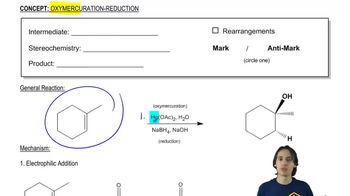Show how you would accomplish the following synthetic transformations. Show all intermediates.
h. hex-1-yne → hexan-2-one, CH3COCH2CH2CH2CH3
 Verified step by step guidance
Verified step by step guidance Verified video answer for a similar problem:
Verified video answer for a similar problem:



 3:51m
3:51mMaster Vinyl alcohols yield tautomers. with a bite sized video explanation from Johnny
Start learning